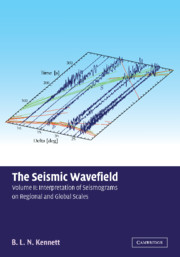Book contents
- Frontmatter
- Contents
- Preface to Volume II
- Part III Local and Regional Events
- 17 Near Events
- 18 Propagation Effects at Near Distances
- 19 Regional Phases I - Propagation in the Crust and Uppermost Mantle
- 20 Regional Phases II - The Influence of Structure
- 21 Propagation in the Upper Mantle
- 22 Upper Mantle Structure
- 23 Analysis of Regional and Far-Regional Seismograms
- Part IV Global Wave Propagation
- Part V The Three-dimensional Earth
- Appendix Paths and Travel times
- Bibliography
- Index
19 - Regional Phases I - Propagation in the Crust and Uppermost Mantle
from Part III - Local and Regional Events
Published online by Cambridge University Press: 31 August 2019
- Frontmatter
- Contents
- Preface to Volume II
- Part III Local and Regional Events
- 17 Near Events
- 18 Propagation Effects at Near Distances
- 19 Regional Phases I - Propagation in the Crust and Uppermost Mantle
- 20 Regional Phases II - The Influence of Structure
- 21 Propagation in the Upper Mantle
- 22 Upper Mantle Structure
- 23 Analysis of Regional and Far-Regional Seismograms
- Part IV Global Wave Propagation
- Part V The Three-dimensional Earth
- Appendix Paths and Travel times
- Bibliography
- Index
Summary
The propagation of seismic phases at regional distances has been a topic of continuous interest since the work of Mohorovičić (1909) on the Kulpatal earthquake in Croatia, from which he proposed the presence of a discontinuity in seismic wavespeeds at a depth near 50 km. The study of crustal structure was pushed forward, mostly using information from natural sources, by many authors including Jeffreys and Conrad. But, it was only when a significant number of records were available from a single source that the full nature of the crustal wavefield could be appreciated.
The first major experiment designed to exploit the refracted waves through the continental crust and mantle was the Heligoland explosion in 1947 (Willmore, 1949) recorded out to 350 km from the source on portable stations, and beyond 700 km at permanent stations. The analysis of crustal and mantle properties using explosive sources to tackle structural problems became a major tool during the 1960s. Initial analysis was based on the interpretation of travel times of the various phases. To try to resolve ambiguities in the models, amplitude information began to be exploited and this lead to the development of both the computation of theoretical seismograms for realistic models (Fuchs & Müller, 1971) and more sophisticated ray-tracing tools (see, e.g., Červený, Pšenčí k & Molotkov, 1977).
Such studies of seismic structure are based on an analysis of the details of seismic arrivals, with emphasis on the correlations between successive seismograms in a record section display. The use of multiple seismograms, with a close spacing in distance, is very helpful in enabling specific types of arrival to be tracked across the record section, so that the influence of noise on individual seismograms can be reduced. The notation used to mark arrivals in such structural studies is designed to provide a detailed correlation between the classes of arrivals and the structural features which give rise to them.
A further impetus to understand the detailed characteristics of the regional wavefield has come from efforts to monitor underground explosions of low yield and to discriminate them from earthquakes (see, e.g., Pomeroy, Best & McEvilly, 1982). In work directed towards source characterisation, the available data commonly consists of a set of seismograms from widely separated arrays or three-component stations.
- Type
- Chapter
- Information
- The Seismic WavefieldVolume II: Interpretation of Seismograms on Regional and Global Scales, pp. 42 - 77Publisher: Cambridge University PressPrint publication year: 2002



